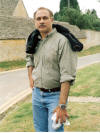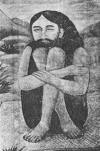|
|
the-south-asian.com July / August 2006 |
|
|||
|
August/September Contents
Sufis - wisdom against 50
years of mountain Heritage cities:
Cotton - the fibre of
|
|
||||
|
Page 3 of
4 Sufi Poet-Saints (cntd) by Salman Minhas
First published May 2001
" Go not far , sasui , nor give up the quest, walk not with your feet, yet sit not quite content, All connection with joys of life snap, Walk with your heart , that the journey may soon end."
Shah Abdul Latif Bhitai
- Poet Laureate of Sindh
`Shah Abdul Latif Bhitai was born in the small village of Bhit [ the mound] about 150 miles north of Karachi . His Urs is held every year between the 13th and 15th of Safar , the second Islamic lunar month. Shah Latif can be said to be the soul of Sindh. He was a great saint , a nationalist , a humanist and a poet whose stature is perhaps on par with the great poets of the world [Byron, Keats , Selley, Neruda, Rilke, Rimbaud, etc ] . Just as the Elizabethan period [ 1500-1700] is known more for Shakespeare than for the empire-builders as Raleigh and Sir Francis Drake [ whose plunder of the Spanish gold armadas earned him the knighthood from the Queen] , so the Kalhora period of Sindh history [ which managed to withstand Nadir Shah's invasion of Delhi in 1739 ] will be remembered more for Shah Latif’s poetry. The Kalhoras period during which Shah Latif lived ,was a period of great prosperity and the towns of Thatta and Hyderabad thrived under the good governance [ low taxes, canal irrigation , textiles ] of the Kalhoras who were originally ruling the north of Sindh near Sukkur. The East India Company described Thatta "as large as London" ; International commerce gave Thatta its prominence with textiles exports and 4000 ships & boats and 400 schools. The Kalhoras were to squeeze out the Sammas and the Soomros who ruled the southern parts of Sindh. The great romance of Sasui-Punhu was born in the Sammas period [ 1300- 1500] and which Shah Latif later made the subject of his Surs.
"Shah Jo Risalo" the message of Shah His poetry was first translated into German in 1866 [a hundred years after his death] by Ernest Trump a German scholar and missionary when in 1860’s he became fascinated by Sindhi language and culture and the jogis and singers who sang Shah Latif’s verses [ganj]. With the help of Sindhi scholars he compiled a selection of the original verses and called it "Shah Jo Risalo" [the message of Shah]. Later in 1940, D.H. Sorley an English scholar learnt Sindhi, and published selections from the Risalo by the Oxford University Press entitled "Shah Abdul latif of Bhit - His Poetry,Life and Times". The most recent work [ 1994], from which most of the translations given here are taken from , is that of Amena Khamisani a professor in English Literature at the Sindh University. Much of Shah Bhitai’s poetry expresses the individual seeking for God in terms of well-known ballads and the negation of the ego. In Islamic tradition the seeker and the sought are both males. Shah following the Indian tradition made his individual a female. Shah’s heroine’s come mainly from the lower strata than the heroes, and yet they outshine the men. The divine is the beloved , with the feminine form associated with earth fertility, nurture, wisdom, and intuition and the masculine with rationality an logic.
|
|||||
|
Copyright © 2000 - 2006 [the-south-asian.com]. Intellectual Property. All rights reserved. |
|||||

